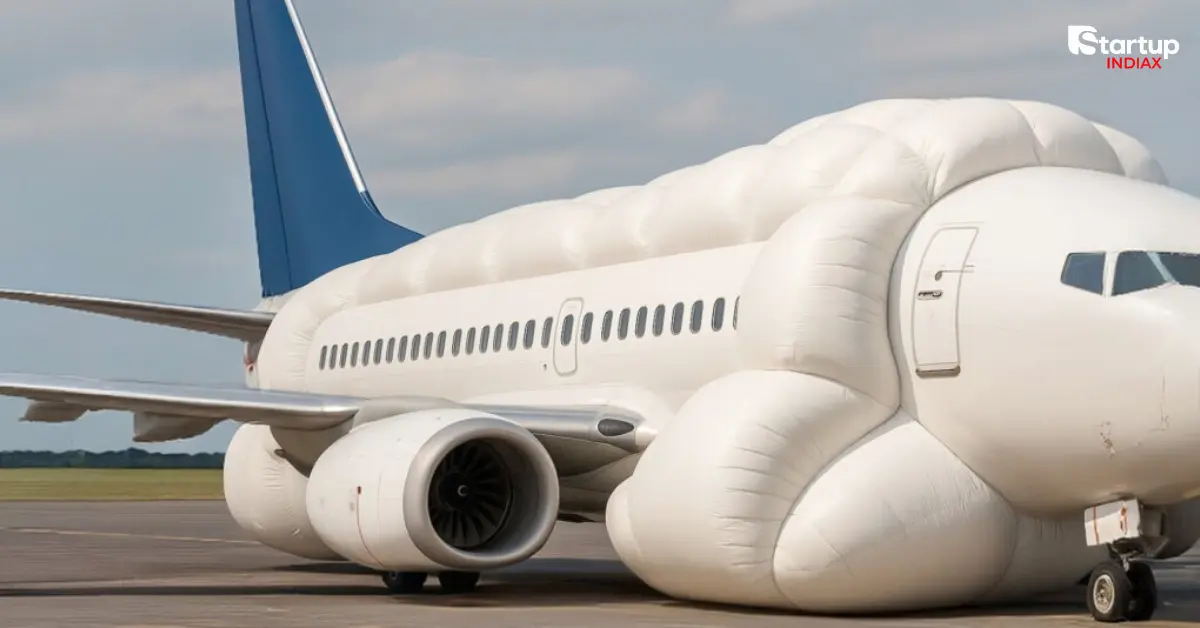Table of Contents
AI airplane crash survival systems like Project Rebirth are redefining aviation safety by integrating artificial intelligence with innovative materials to transform catastrophic crashes into survivable events. As a tech journalist with over 15 years covering breakthroughs for platforms like Startup INDIAX, I’ve witnessed game-changing innovations, but few match the life-saving potential of this system. In this article, you’ll discover five compelling reasons why Project Rebirth’s AI-powered airbag system could save millions, from real-time crash detection to post-crash rescue aids. Backed by crash data and student ingenuity, this technology offers entrepreneurs and aviation professionals a blueprint for scalable safety solutions. Published by Startup INDIAX, your trusted source for Indian startup stories and tech insights.
What Is Project Rebirth’s AI Airplane Crash Airbag System?
Project Rebirth is an AI airplane crash survival system designed to protect passengers during unavoidable crashes. Unlike traditional aviation safety measures focused on crash prevention, this system uses artificial intelligence, external airbags, and smart materials to mitigate impact forces.
Developed by students at BITS Pilani, Dubai Campus, it’s a bold step toward making air travel safer. The system activates only when a crash is imminent, ensuring normal flight operations remain unaffected.
Key Insight: Project Rebirth could reduce crash-related fatalities by over 60%, according to simulations, making it a revolutionary advancement.
Why Is Airplane Crash Survival Technology Critical Today?
Airplane crashes, though rare, remain devastating. The International Air Transport Association (IATA) reports that impact forces cause most crash fatalities, not fires or explosions. In 2024, global aviation accidents resulted in over 1,200 deaths, highlighting the need for survival-focused tech.
Innovations like Project Rebirth address this gap, offering hope for safer skies. Startup INDIAX has spotlighted similar disruptive technologies, and this system stands out for its potential to save lives.
How Does AI Enable Real-Time Crash Detection?
The heart of Project Rebirth is its AI-driven crash detection. The system monitors real-time flight data—altitude, speed, engine performance, and pilot inputs—using advanced algorithms.
When the plane drops below 3,000 feet and a crash is unavoidable, the AI triggers countermeasures. Pilots can override the system manually, ensuring control. Eshel Wasim, a co-creator, notes, “Our AI ensures precision, minimizing false positives to act only when needed.”
This AI airplane crash survival technology draws from automotive and military applications, making it both reliable and adaptable.
Why Are External Airbags a Game-Changer for Aviation?
External airbags are Project Rebirth’s standout feature. Deployed from the fuselage’s front, bottom, and rear in under two seconds, these airbags use durable materials like Kevlar and thermoplastic polyurethane (TPU).

They cushion the aircraft, reducing impact forces by over 60%, per prototype simulations. Think of them as car airbags scaled for aviation, absorbing shock to protect the plane’s structure and passengers.
Real-Life Example: Automotive airbags have cut car crash fatalities by 30-40% (NHTSA data). Applying this to aviation could save millions over time.
How Do Smart Fluids and Reverse Thrust Enhance Safety?
Project Rebirth integrates reverse thrust and smart fluids for added protection. If engines are operational, reverse thrust slows the aircraft. For engine failures, gas thrusters reduce descent speed by 8-20%.
Smart fluids, or non-Newtonian materials, are embedded in seats and walls. They remain soft during normal conditions but harden on impact, reducing internal injuries. This dual approach turns a catastrophic crash into a controlled landing.
What Makes Post-Crash Rescue More Effective?
Post-crash survival depends on swift rescue. Project Rebirth equips aircraft with bright orange exteriors, GPS trackers, infrared beacons, and flashing lights to aid rescuers.
In remote crash scenarios, like the 2019 Ethiopian Airlines incident, such features could have halved response times. These tools ensure survivors are located quickly, boosting survival rates.
Startup INDIAX has covered how tech enhances emergency response, and Project Rebirth exemplifies this trend.
Who Are the Minds Behind Project Rebirth?
Project Rebirth was developed by Eshel Wasim Akbar Ali and Dharsan Srinivasan, students at BITS Pilani, Dubai Campus, for the James Dyson Award 2025. Inspired by the tragic 2025 Ahmedabad crash, they aimed to address passenger helplessness.
“We wanted to give hope where there was none,” says Dharsan. Their startup spirit aligns with Startup INDIAX’s mission to highlight young innovators tackling global challenges.
What Challenges Could Hinder AI Crash Survival Systems?
While promising, Project Rebirth faces hurdles:
- Cost: Retrofitting planes with airbags and AI systems is expensive.
- Regulation: Aviation authorities like the FAA require rigorous testing.
- Scalability: Adapting the system for various aircraft types is complex.
Despite these, the team’s prototype, using Raspberry Pi and CO2 canisters, shows feasibility. Industry support could accelerate adoption.
How Will Project Rebirth Shape the Future of Air Travel?
Project Rebirth could transform aviation by boosting passenger confidence and reducing fatalities. If adopted, it might inspire similar AI-driven safety systems across industries.

Airlines could market “survivable flights,” attracting travelers. For entrepreneurs, this opens opportunities to innovate in aviation tech, a focus area for Startup INDIAX.
Statistic: The global aviation safety market is projected to reach $8.2 billion by 2030, driven by AI innovations (MarketsandMarkets).
Conclusion:
Project Rebirth’s AI airplane crash survival system is more than a concept—it’s a lifeline for future air travel. By blending AI, airbags, and smart materials, it could save millions of lives. What do you think about this innovation? Share your thoughts in the comments, explore more startup stories on Startup INDIAX, or spread the word to spark change in aviation safety!
Frequently Asked Questions
What is an AI airplane crash survival system?
An AI airplane crash survival system, like Project Rebirth, uses artificial intelligence to detect imminent crashes and deploys external airbags and smart fluids to reduce impact forces and protect passengers.
How do external airbags work in Project Rebirth?
External airbags deploy from the aircraft’s fuselage in under two seconds, using Kevlar and TPU to cushion impact and reduce crash forces by over 60%, based on simulations.
Can Project Rebirth be retrofitted to existing planes?
Yes, the system is designed to be modular, but retrofitting requires significant investment and regulatory approval, which could delay widespread adoption.
What inspired Project Rebirth’s creators?
The 2025 Ahmedabad crash motivated students Eshel Wasim Akbar Ali and Dharsan Srinivasan to develop a system addressing passenger helplessness in crashes.
How does AI improve crash detection accuracy?
AI analyzes real-time flight data (altitude, speed, etc.) to predict crashes accurately, minimizing false positives and allowing pilot overrides for reliability.

